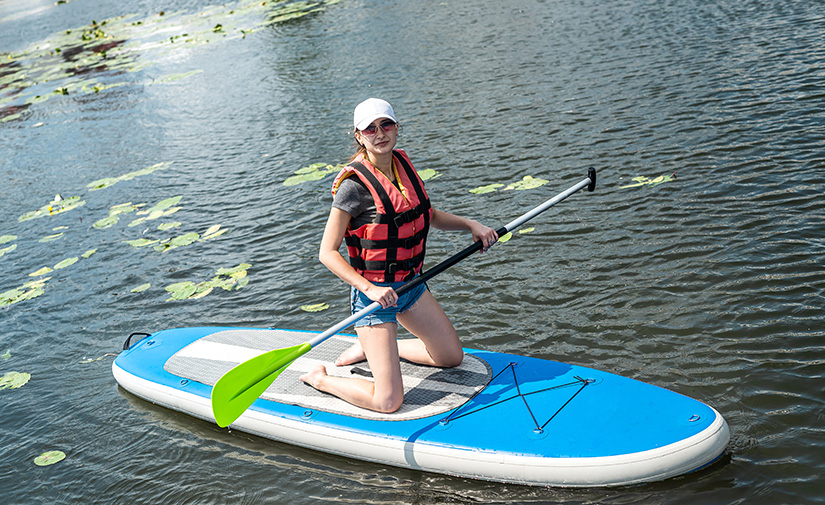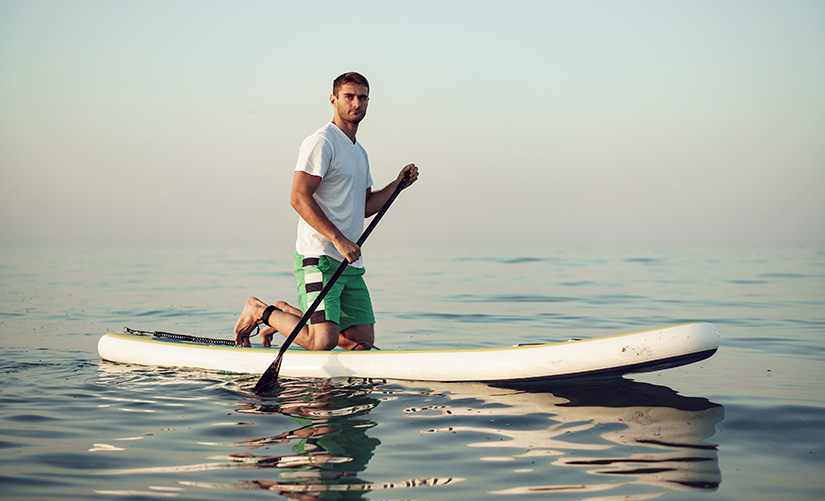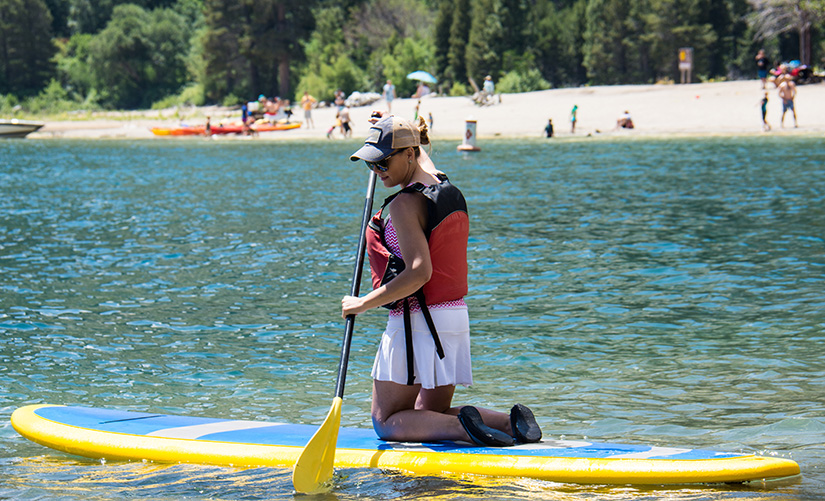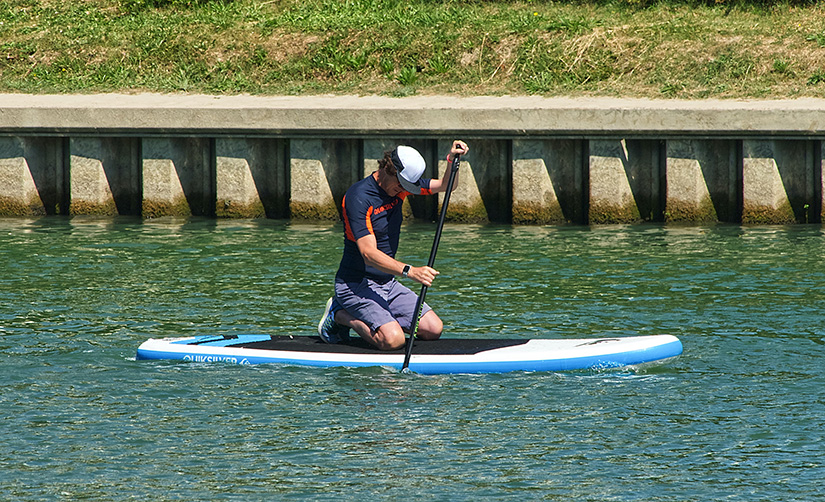Just because it’s called stand up paddle boarding doesn’t mean you always have to stand up when doing it. And that’s the beautiful thing about SUP. There are many ways of having fun and getting a good workout on your paddle board–like knee paddling.
Why would someone choose to paddle on their knees?
You could be a beginner looking for more stability or a paddler paddling against the wind wishing to minimize resistance.
Whatever the reason, it’s still important to do it right, to ensure that you avoid injury, and for maximum paddling efficiency. I’m going to discuss when, and how, to paddle board on your knees.
Can You Paddle Board on Your Knees?
Yes, you can paddle board on your knees.
Stand up paddle boarding is typically done standing up (as the name would suggest), but you can still paddle while in a kneeling and sitting position if you like. Sometimes you may be forced to get lower by circumstances and other people just prefer to alternate between kneeling and standing for their comfort.
Lately, it even seems like some paddlers are trying to make knee paddle boarding a SUP discipline on its own. I’ve seen paddle boards designed specifically for knee paddling.
Paddle Boarding on Your Knees
The main difference between knee SUP and regular paddle boarding is your paddling position and how you hold your paddle.
How to Get in the Knee Paddling Position
Walk with your paddle board into the water until it’s about knee-deep and place your board nicely on the water.
With both hands on either side of the paddle board, hold it steady and climb onto it. Adjust your position until you find balance–not too far forward, not too far back, and don’t lean too much on either side. Start paddling.
If you’re standing on your SUP and want to kneel, bring your paddle board to a stop. Bend and hold the board on either side to make it more steady. Slowly bring your knees down. Look ahead and start paddling.
It’s that simple!
How to Hold Your Paddle When Paddling on Your Knees
When paddling while kneeling, you’ll notice that holding your paddle the normal way just doesn’t work. You’ll have to rearrange your hand positions to make your paddle strokes more efficient.
Instead of having one hand on the T-bar at the top, both hands will be on the paddle shaft. Your lower hand should be closer to the blade and your upper hand just above the middle point of the shaft.
The exact hand position will vary from paddler to paddler depending on body size and height of the paddle. Try a few hand positions to find the one that gives you the best leverage.
Adjust the Length of Your Paddle
You’ll be much shorter on your knees which means that your usual paddle height may not be as comfortable as when you’re standing.
Paddle boarders with adjustable paddles are in luck here. If you can adjust the height of your paddle, make it as short as possible so it can be more manageable.
Making a Proper Paddle Stroke When Paddling in a Kneeling Position
Even when you’re knee paddle boarding, you’ll still need to use the right paddling technique. It will help you get a good workout by engaging different muscle groups. It will also prevent you from getting hurt because poor technique can result in injury.
First, fix your posture. You can kneel upright, sit on your heels, or alternate between the two. Feel free to do what makes you comfortable. But remember to keep your back nice and relaxed, just like you do when stand up paddle boarding.
Don’t arch and slouch because you want the power to come from the shoulder, back, and core muscles. This way, you won’t overwork your arms.
Reach far forward with your paddle and bury your blade completely into the water. Once it gets to your feet, remove it from the water.
Try to keep the paddle shaft as vertical as possible, with the upper hand directly above the bottom hand. Also, keep the blade as close to the SUP board rail as possible. This will help your paddle board move in a straight line.
When Should You Paddle Board on Your Knees?
Stand up paddling is fun and it’s certainly one of the best full-body workouts. Sometimes, however, kneeling may be the better option.
If You’re a Beginner and Need More Stability
Being on your knees lowers your center of gravity and gives you added stability, which is useful, since beginners may find balancing on a SUP a little challenging at first.
Falling off the paddle board can be frustrating when you’re trying to learn how to paddle board, so kneeling is good to help limit the amount of time you end up overboard.
If you’re a newbie and the standing position is proving to be tricky, try the kneeling position. You will be more stable on the SUP board which means you won’t fall off as much. You can focus on familiarizing yourself with the board and finding a comfortable middle point.
It’s also nice to just spend some time mastering the right paddling technique without worrying about falling off.
Besides, you’ll still be getting a good workout while on your knees.
Once you feel confident enough you can try standing.
When the Wind Picks Up
Stand up paddle boarding can be heavily dependent on the weather. Factors like the wind can have a huge impact on your paddling experience. This is why you should always check the weather forecast before heading out.
However, the weather changes and sometimes you can be caught up in high winds unexpectedly. Now, this isn’t a problem if you’re paddling in the direction of the wind. If anything, paddling will be easier because the wind will be giving you a boost.
It’s another story when paddling into the wind. The resistance from the wind will give you a tough time. While in the standing position, your body acts as a sail which translates to more resistance, making things harder.
When you lower yourself by kneeling on your SUP board, you reduce the surface area and, in turn, the resistance. You’ll be able to make more efficient paddle strokes and regain better control of your paddle board.
When Water Conditions Start Getting Rough
Like strong winds, rough water conditions can make your paddle boarding session unpleasant.
For instance, choppy waters or big waves can easily knock you off your paddle board. And when you’re dealing with difficult conditions, you want to make sure you stay on board and get back to shore as soon as you can.
So if you suddenly find yourself in such a situation, get into the kneeling position. Your center of gravity will be lower and you’ll be less likely to fall on the board. Like knee paddling in high winds, you’ll also have more control of your paddle board.
In Shallow, Unsafe Waters
Falling off your paddle board isn’t usually a big deal and is even to be expected. But in shallow waters, it’s easy to get hurt if you hit something hard at the bottom.
I would recommend avoiding shallow water altogether, especially if you’re paddling in an unfamiliar location. Obstacles in the water, like rocks, can be dangerous. It’s easy to get hurt or damage your paddle board.
However, sometimes shallow water paddling is unavoidable.
This is where knee paddle boarding comes in handy. As I’ve mentioned several times here, kneeling gives you great balance.
Should you fall, you’re better off falling from a kneeling position than a standing position. You’ll hit whatever obstacle is in the water with less force and reduce the chances of getting seriously hurt.
Transitioning from the Kneeling Position to the Standing Position
How do you go from kneeling on a SUP board to standing?
Hold the paddle board on either side to keep it from getting too tippy. Move one foot forward to replace your knee and then the other one. Your feet should be on either side of the center carry handle.
Slowly stand and start paddling immediately to remain balanced. Keep your knees slightly bent, your back straight and relaxed, and your eyes focused ahead.
Wrapping Up
There comes a time when knee paddle boarding is your best option. It’s a good position when you still want to get a good workout but have some added stability.
Beginners and paddle boarders in rough conditions will find that it’s easier to remain balanced when knee paddling. It’s also a great option when paddling in shallow unsafe waters.
To make your paddle strokes more effective, change how you hold your shaft. Position both hands on the shaft, with the bottom hand closer to the paddle blade. If your paddle is adjustable, consider making it shorter as that will make it easier for you to use it while in a kneeling position.
Just like when you’re standing, you’ll need to keep your back neutral. Make sure you’re getting most of the power for your strokes from the core, back, and shoulder muscles. This way, you won’t get worn out too quickly, and can paddle on your knees safely and efficiently.
Now that you’ve read this guide, you’ll hopefully be more confident about paddle boarding on your knees, as well as sure about when it’s a good time to employ this tactic.




